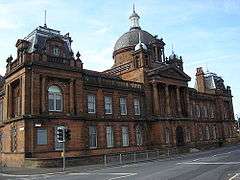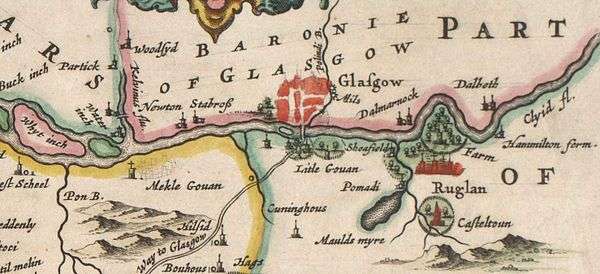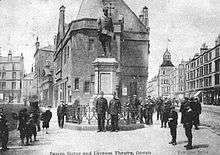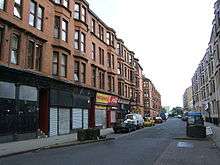Govan
| Govan | |
| Scottish Gaelic: Baile a' Ghobhainn | |
| Scots: Gouan | |
 Govan Burgh Hall |
|
 Govan |
|
| OS grid reference | NS555655 |
|---|---|
| – Edinburgh | 45 mi (72 km) E |
| – London | 346 mi (557 km) SSE |
| Council area | Glasgow City Council |
| Lieutenancy area | Glasgow |
| Country | Scotland |
| Sovereign state | United Kingdom |
| Post town | GLASGOW |
| Postcode district | G51 |
| Dialling code | 0141 |
| Police | Scottish |
| Fire | Scottish |
| Ambulance | Scottish |
| EU Parliament | Scotland |
| UK Parliament | Glasgow South West |
| Scottish Parliament | Glasgow Pollok Glasgow Southside |
Coordinates: 55°51′41″N 4°18′30″W / 55.8615°N 4.3083°W
Govan (/ˈɡʌvən/ GUV-ən; Scottish Gaelic: Baile a' Ghobhainn) is a district, parish, and former burgh now part of southwest City of Glasgow, Scotland. It is situated 2.5 miles (4.0 km) west of Glasgow city centre, on the south bank of the River Clyde, opposite the mouth of the River Kelvin and the district of Partick. Historically it was part of the County of Lanark.
According to medieval legend, Constantine, a 7th-century King of Strathclyde, founded a monastery under the rule of Columbanus in Govan. During the Middle Ages, Govan was the site of a ferry which linked the area with Partick for seasonal cattle drovers. In the 18th and 19th centuries, textile mills and coal mining were important; in the early 19th century shipbuilding emerged as Govan's principal industry. In 1864, Govan gained burgh status, and was Scotland's fifth largest burgh. It was incorporated into the city of Glasgow in 1912.[1]
History
Early history
Recent studies of the archaeology of old Govan have revealed the presence of an ancient Christian church. Two associated Christian burials are radiocarbon dated to the 5th or 6th centuries, making Govan the earliest known Christian site in the region.[2] Govan is believed to have then been part of a kingdom ruled from Dumbarton Rock, known as Alt Clut, the rock on the Clyde. During the Viking Age, perhaps following the sack of Dumbarton Rock in 878, Govan is believed to have been one of the major centres of the Kingdom of Strathclyde. According to John of Fordun, Constantine, a 7th-century king of Strathclyde, founded a monastery at Govan, where he died and was buried. In 1855, an elaborately carved sandstone sarcophagus was found during digging in the churchyard.[3] It is now kept inside the church. It may have been used to contain the body or relics of Constantine, although the style of carving indicates an origin in the 10th or 11th centuries.[4] This King Constantine is first mentioned in the 12th-century Life of St. Kentigern by Jocelyn of Furness, where he is said to have been son of Riderch Hael.[5] He is likely a literary invention. The early church in Govan is dedicated to a Saint Constantine, about whom nothing else is known.[5]
Govan's earliest recorded name may be found in the Historia Regnum Anglorum attributed to Symeon of Durham. This is a 12th-century Latin source, but one believed to be based on much earlier materials; it records a place near Dumbarton Rock named Ouania. Based on this, Govan's Cumbric language name has been reconstructed as *(G)uovan.[6] Govan is Baile a' Ghobhainn (the smith's town) in Scottish Gaelic. Bishop Leslie in his Scotia Descriptio of 1578 says it got its name from the excellence of its ale (God-win), whereas Chalmers in his Caledonia says it is derived from Scottish Gaelic, Gamhan (a ditch).[7]
The earliest references to Govan are found in connection with the Christian church. In 1136, when Glasgow Cathedral was formally consecrated, King David I (1124–53) gave to the See the lands of Partick and also of the church at Govan (on opposite sides of the River Clyde), which became a prebend of Glasgow. The Govan Old Parish Church was rebuilt in 1762, 1826, and again 1884-1888. Within it and its roughly circular churchyard is one of the finest collections of Early Christian stones in the United Kingdom, dating from the 10th and 11th centuries.
By the 16th century, extensive coal mine workings had been developed around Craigton and Drumoyne. As the village grew, new trades and crafts, such as weaving, pottery and agriculture, were established.

There is an oddity whereby part of eighteenth-century parish of Govan (which was in Lanarkshire) is counted as being within Renfrewshire. There existed a hospital in the area, and as quasi-religious foundations were not taxed, it had never been assigned to a sheriffdom. Thus, when Renfrewshire was created out of a sheriffdom of Lanarkshire in the early fifteenth century, the lands associated with the hospital (Polmadie) were not technically in the newly created shire, as they were not part of the sheriffdom. They were, however, very much a part of the physical landscape that became Renfrewshire. A similar uncertainty existed regarding the nearby lands of Pollokshields and Westends. People lived with the inconsistency in the records. When the railway was to be built in the late nineteenth century, however, the confusion over proper descriptions in the land titles made necessary legal transactions difficult and had to be reconciled. The county added to the description of these lands, the phrase: "but now by annexation in the County of Renfrew."[8]

By the early part of the 19th century, Govan was rapidly losing its rural appearance and assuming the character of a town with the development of new industries and factories, including Reid's Dye Works and Pollok's Silk Mill. Town officials arranged for the deepening of the Clyde in 1759, the reclamation of the channels between the islands (The Whyte Inch, The Black Inch, and The King's Inch), and the construction of quays and docks. This facilitated the development of shipbuilding as a major industry. By the 1860s, the village needed a higher order of administration and it was made a burgh in 1864, under the General Police (Scotland) Act 1862. At the time, it was the fifth largest burgh in Scotland and contained within its boundaries, the areas of Plantation, Cessnock, Ibrox, Craigton and Drumoyne.[9] in 1901 the Burgh boundaries increased further west to include Linthouse and West Drumoyne.[10]
With Morris Pollok as its first Provost, the Burgh and its Commissioners ensured that during the next 48 years Govan became a well-equipped, modern town. During the late 19th century, the population of Govan increased more than tenfold: from 9,000 in 1864 to 95,000 by 1907. In 1901 Govan was the 7th largest town in Scotland.[11] In 1912, Glasgow annexed Govan after a series of annexation battles.[12][13]
A prominent feature of the Govan landscape was the Doomster or Moot Hill, which stood near the river, north of the present Govan Cross. It was removed in the early 19th century and Reid's Dyeworks was erected on the site. The origins of the Doomster Hill are a mystery. One hypothesis is that it was a prehistoric burial mound. In 1996, a team from Channel 4's Time Team programme carried out an archeological excavation at the site. They suggested that the hill may have been a 12th-century Norman motte.[14]
20th century to the present
Traditionally viewed as a lower working-class area, Govan has typically supported the Labour Party, but the Scottish National Party (SNP) has also been strong there. In 1973 SNP won a by-election with Margo MacDonald as their candidate. The SNP won another by-election victory in 1988, this time with Jim Sillars as candidate. The latest victory for the SNP was in the 2007 Scottish parliamentary elections, when Nicola Sturgeon became the MSP for the constituency.
The area has had a reputation for deprivation and poverty, partly due to the construction of housing estates in the 1930s to relieve the overcrowded slum district of The Gorbals, Glasgow. The most famous of these housing estates is Moorpark, sometimes referred to jocularly as "The Wine Alley" - this area was named by The Independent newspaper in April 1994 as one of the worst areas in Britain, with drug abuse being a widespread problem and unemployment standing at nearly 30% (up to three times the national average at the time).[15]
It was parodied by the BBC sitcom Rab C. Nesbitt. Although Govan was the stated setting for the show, episodes were seldom filmed there. In the post-war years, many Govanites were relocated from the town, often reluctantly, to outlying areas such as Drumchapel, Pollok, Darnley, Priesthill and Penilee by the Corporation of Glasgow.
Despite these developments, there were numerous older buildings around Govan until quite recently, most notably the terraces and tenements situated around Govan Road. These were not cleared until well into the 1970s.
Due to boundary changes, Govan in the early 1960s incorporated some surrounding more prosperous areas at its boundaries. Although technically part of Govan, residents of these areas have maintained a distinct identity separate from the area.
The Govan Fair is celebrated on the first Friday in June each year.
Economy

Govan was at one stage the centre of the world-renowned Clydeside shipbuilding industry, but few shipyards remain today. One of Govan's original yards is one of only two large shipyards to survive on the Upper River Clyde, the other being Yarrow Shipbuilders Limited based in Scotstoun. These two yards form a large part of BAE Systems Surface Ships.
In 1841, Robert Napier began iron shipbuilding in Govan, and in 1843 produced its first ship, the Vanguard. He also procured a contract with the Royal Navy to produce vessels, notably the Jackal, the Lizard, and the Bloodhound. He also allowed naval officers in training to visit the shipyard to familiarise themselves with the new vessels. Napier's Shipyard in Govan was later acquired by William Beardmore and Company in 1900 before being sold on to Harland & Wolff in 1912. It finally closed in 1962 and most of the site was redeveloped into housing.
Govan's other major shipbuilding firm was founded in the 1860s as Randolph, Elder and Company, later becoming John Elder and Company. In 1885 the yard moved further west to its present site and was reorganised as the Fairfield Shipbuilding and Engineering Company Ltd. This company continued until 1965 when it filed for bankruptcy. In response in 1966, the yard was again reorganised as Fairfields and guaranteed by the government. The following year Fairfields and the other major Clydeside yards (Stephens, Connels, Yarrows and John Browns) were merged to form Upper Clyde Shipbuilders (UCS).
In 1971 Upper Clyde Shipbuilders went into receivership and the Tory government under Edward Heath refused it a £6m loan. Rather than go on strike, which was the traditional form of industrial action, the union leadership of the yards decided to have a work-in and complete the orders that the shipyards had in place. In this way they dispelled the idea of the workers being 'work-shy' and also wanted to illustrate the long-term viability of the yards. The work-in was successful in the short-term. YSL withdrew from UCS in 1971 and Govan was sold off in 1973 as Govan Shipbuilders.
In 1977, the Labour government of James Callaghan passed the Aircraft and Shipbuilding Industries Act which nationalised Govan and grouped it with other major British shipyards as British Shipbuilders. In May 1979, Margaret Thatcher was elected Prime Minister and her administration soon began its privatisation programme. British Aerospace, established by the same act, was privatised in 1981. British Shipbuilders' road to privatisation was not as swift, and the group was sold piece by piece in the course of the 1980s.
Kværner of Norway, as part of a planned development of a large international shipbuilding group, took over Govan.[16] British Shipbuilders' sale of Govan to the Norwegian firm was completed in 1988 and the yard was renamed Kvaerner Govan.[17]
In 1999, GEC's Marconi Marine division purchased the yard when Kværner announced its exit from the shipbuilding industry.[17] GEC's Marconi Marine division already owned YSL (purchased in 1985) and VSEL (purchased in 1995). Marconi Electronic Systems and its Marconi Marine unit were sold to British Aerospace in 1999 to form BAE Systems. The shipbuilding operations became BAE Systems Marine, which subsequently became part of BVT Surface Fleet, a naval shipbuilding joint venture between BAE Systems and VT Group, which became BAE Systems Surface Ships in 2009.
Alexander Stephen and Sons also established a Shipyard in nearby Linthouse in 1870. The yard eventually closed in the wake of the collapse of the Upper Clyde Shipbuilders consortium in 1971.
Ships built at Govan
- PS Vanguard (1843)[18]
- HMS Northampton (1876)
- HMS Nelson (1876)
- HMS Curacoa (1878)
- SS Arizona (1879)[19]
- Ibis (1886)[18]
- Akasha (1886)[18]
- Livadia (1880)[19]
- Victoria (1886)[19]
- RMS Campania (1891)
- RMS Lucania (1893)
- HMS Cressy (1899)
- HMS Aboukir (1900)
- HMS Good Hope (1901)
- HMS Bedford (1901)
- SS Armadale Castle (1903)[19]
- RMS Port Kingston (1904) renamed RMS Tahiti
- HMS Cochrane (1905)[19]
- HMS Commonwealth (1905)[19]
- RMS Empress of Britain (1906)[19]
- RMS Empress of Ireland (1906)[19]
- SS Volturno (1906)
- HMS Indomitable (1907)[19]
- SS Balmoral Castle (1910)[19]
- HMS New Zealand (1911)
- HMAS Sydney (1912)
- RMS Empress of Russia (1913)[19]
- RMS Empress of Asia (1913)[19]
- SS Calgarian (1913)[19]
- HMS Valiant (1914)
- HMS Renown (1916)
- RMS Empress of Canada (1922)[19]
- SS Athenia (1922)
- Aorangi (1922)
- TSS Tuscania (1923)
- SS Letitia (1924)
- MV Speybank (1926)
- HMS Berwick (1926)
- HMS Norfolk (1928)
- RMS Empress of Japan (1930)
- HMS Delight (1932)
- HMS Woolwich (1934)
- HMS Liverpool (1937)
- HMS Phoebe (1937)
- HMS Howe (1940)
- HMS Bellona (1942)
- HMS Implacable (1942)
- HMS Theseus (1944)
- HMS Chichester
- HMS Blake (1945)
- SS Karanja (1948)
- TS Oxfordshire (1955)
- TS/SS Empress of Britain (1956)[18][20]
- TS Leecliffe Hall (1961)
- HMS Fife (1964)
- HMS Antrim (1967)
- USNS Harkness (1968)
- HMAS Jervis Bay (1969)
- Pacifique (1969)
- USNS Chauvenet (1970)
- Pacific Peace (1981)
- MV Selkirk Settler (1983)
- MV Saskatchewan Pioneer (1983)
- St. Lawrence Seaway (1983)
- Sir Charles Parsons (1985)
- MV Norsea (1986)
- MV Havis (1992)
- Sea Launch Commander (1996)
- RFA Wave Ruler (2003)[21]
- RFA Mounts Bay (2004)[22]
- HMS Daring (2006)
- HMS Dauntless (2007)
- HMS Diamond (2007)
- HMS Dragon (2008)
- RMS Yerdasda (2009)
- HMS Defender (2009).[23]
- HMS Duncan (2010)
A list of almost 3000 ships built at Govan has been collected in the 'Clydebuilt Database'.[24] The ships were built by the following companies: Robert Napier & Company, Randolph Elder & Company, Dobbie Hedderwick & Co., Dobie & Company, Mackie & Thomson, Smith & Rodgers, London & Glasgow Engineering and Iron Shipbuilding Co. Ltd., William Beardmore & Company, John Elder & Company, Fairfield Shipbuilding & Eng. Co. Ltd., Alexander Stephens & Sons, J & G Thomson, Harland & Wolff and more.
Transport
Govan is served by Govan Subway Station, Ibrox Subway Station and Cessnock Subway Station on the Glasgow subway system.
Govan railway station opened on 2 December 1868. It closed permanently to regular passenger services on 9 May 1921.
Regular bus services, mainly operated by McGill's Bus Services and First Glasgow, offer frequent routes to Glasgow City Centre, as well as to numerous locations in Renfrewshire.
Sports
Govan borders the district of Ibrox, home to the Scottish football club Rangers F.C. Ibrox Stadium has a stand named for Govan with the stadium itself being 1 of only 27 football stadiums in Europe to be ranked by UEFA as a UEFA Category four stadium. This stadium has staged many great events, but was the scene of one of the world's worst sporting tragedies in January 1971, when 66 Rangers fans were trampled to death on a stairwell leaving the ground.
Govan is home to the popular Scottish junior football team Benburb F.C. who (until March 2014) played at Tinto Park, Craigton. They share a rivalry with St Anthony's F.C. who once hailed from the Helen Street district of Govan but who are now based further to the west at Cardonald. Linthouse F.C. were a successful senior side, who fell into decline and are now defunct.
Media
Govan is served by community Radio Station Sunny Govan broadcasting on 103.5FM to the city of Glasgow and surrounding districts, discussing local issues and providing advice, and with diverse musical output covering soul, hip-hop and reggae.
Govan has had several local newspapers over the years such as the Govan Chronicle and Govan Press published by the Cossar Family (1851-1983 & 2006–present) which also serves the communities of Cardonald, Penilee and Hillington and the Govan Post (1983–1988) published by Cook, Paton & Co. of Paisley, now part of Dunfermline Press.
List of Provosts of Govan
- 1864-1867 Morris Pollok
- 1867-1869 William Cruickshank
- 1869-1872 Thomas Reid
- 1872-1880 James Wilson
- 1880-1883 John Thompson
- 1883-1886 Alexander Campbell
- 1886-1889 George Ferguson
- 1889-1892 Neil McLean
- 1892-1901 James Kirkwood
- 1901-1904 John Marr
- 1904-1908 John Anthony
- 1908-1912 David McKechnie
Popular culture
- Scottish TV Series Rab C Nesbitt is set in Govan although the series is largely filmed elsewhere.
Notable people
- James Hedderwick, poet and newspaper proprietor, born and raised in Govan
- George MacLeod, minister of the Church of Scotland's Govan Old Parish Church. He founded the Iona Community, whose offices are still based in Govan.
- Belle Moore, Olympic Gold Medalist,
- Sir Alex Ferguson, football player and manager
- Kenny Dalglish, football player and manager
- Jimmy Reid, trade unionist[25]
- Johnny Quigley, football player[26][27]
- Iain Robertson, actor[28]
- Leo Blair (senior), father of former Prime Minister Tony Blair and high court judge Sir William Blair, was raised on Golspie Street.
- James Kelman, writer[29]
- David Meiklejohn, Glasgow Rangers footballer, who also captained Scotland on a number of occasions.
- Mary Barbour, resident in Govan while helping organise the Glasgow Rent Strikes
Notes
- ↑ Reevel Alderson (7 August 2012). "How Glasgow annexed Govan and Partick 100 years ago". BBC News. Retrieved 8 August 2012.
- ↑ Driscoll, Stephen, "Govan, an early medieval royal centre", p. 79.
- ↑ Govan Sarcophagus, The Glasgow Story
- ↑ "Govan Stones: The Viking-Age treasures". BBC. 2014-01-27. Retrieved 2014-06-09.
- 1 2 Clarkson, Tim (Winter 1999). "Rhydderch Hael". The Heroic Age. 1 (2). Retrieved 12 August 2009.
- ↑ Koch, John, "Ovania", p. 34.
- ↑ "A History Of Glasgow & Govan (1883)", Ordnance Gazetteer Of Scotland
- ↑ Scott, Alexander (1890). "Notes on the Lands of Polmadie and Crosshill". Transactions of the Glasgow Archaeological Society. I. Glasgow: James Maclehose & Sons. pp. 530–532. (available at books.google.com)
- ↑ "2nd Edition Ordnance Survey". 1893–94. Retrieved 2012-04-16.
- ↑ "3rd Edition Ordnance Survey". 1913. Retrieved 2012-04-16.
- ↑ "Scotland: Population", Britannica Encyclopedia, 1911
- ↑ "Annexation Battles". Retrieved 2012-05-01.
- ↑ Alderson, Reevel (7 August 2012). "How Glasgow annexed Govan and Partick 100 years ago". BBC News. BBC. Retrieved 13 August 2012.
- ↑ Time Team Series 4, episode 4. First broadcast 26 January 1997.
- ↑
- ↑ Birkler, J.L. et al. (2002). The Royal Navy's New-generation Type 45 Destroyer: Acquisition Options and Implications, p. 13.
- 1 2 Birkler, p. 14.
- 1 2 3 4 Clydebuilt Database - Shipping Times, Stuart Cameron
- 1 2 3 4 5 6 7 8 9 10 11 12 13 14 Johnston, Ian. "Govan Shipyard" in Ships Monthly. June 1985.
- ↑ "Shipping Times". Retrieved 2008-03-17.
- ↑ Royal Navy, Royal Fleet Auxiliary (RFA): RFA Wave Ruler
- ↑ Royal Navy, Royal Fleet Auxiliary (RFA): RFA Mounts Bay
- ↑ Stewart, Catriona (21 October 2009). "Clyde's new ship to make a splash". Evening Times. Evening Times. p. 22.
- ↑ Ships Built at Govan Acumfaegovan.
- ↑ http://www.universitystory.gla.ac.uk/biography/?id=WH1061&type=P
- ↑ "FA Cup Final 1959", Nottingham Forest
- ↑ GRO Scotland
- ↑ "Iain Robertson", Sunny Govan
- ↑ http://www.theguardian.com/books/2012/jul/29/james-kelman-why-is-my-work-so-upsetting
References
- "Aircraft and Shipbuilding Industries Act 1977 (c. 3) Schedule 2 Shipbuilding Industry". UK Statute Law Database. 1977. Retrieved 2007-04-28.
External links
- Govan Community Council
- Govan Architecture and History
- Get into Govan
- Govan, the Place and the People
- Fairfield Heritage
- Govan Maps 1857-1934, National Library of Scotland